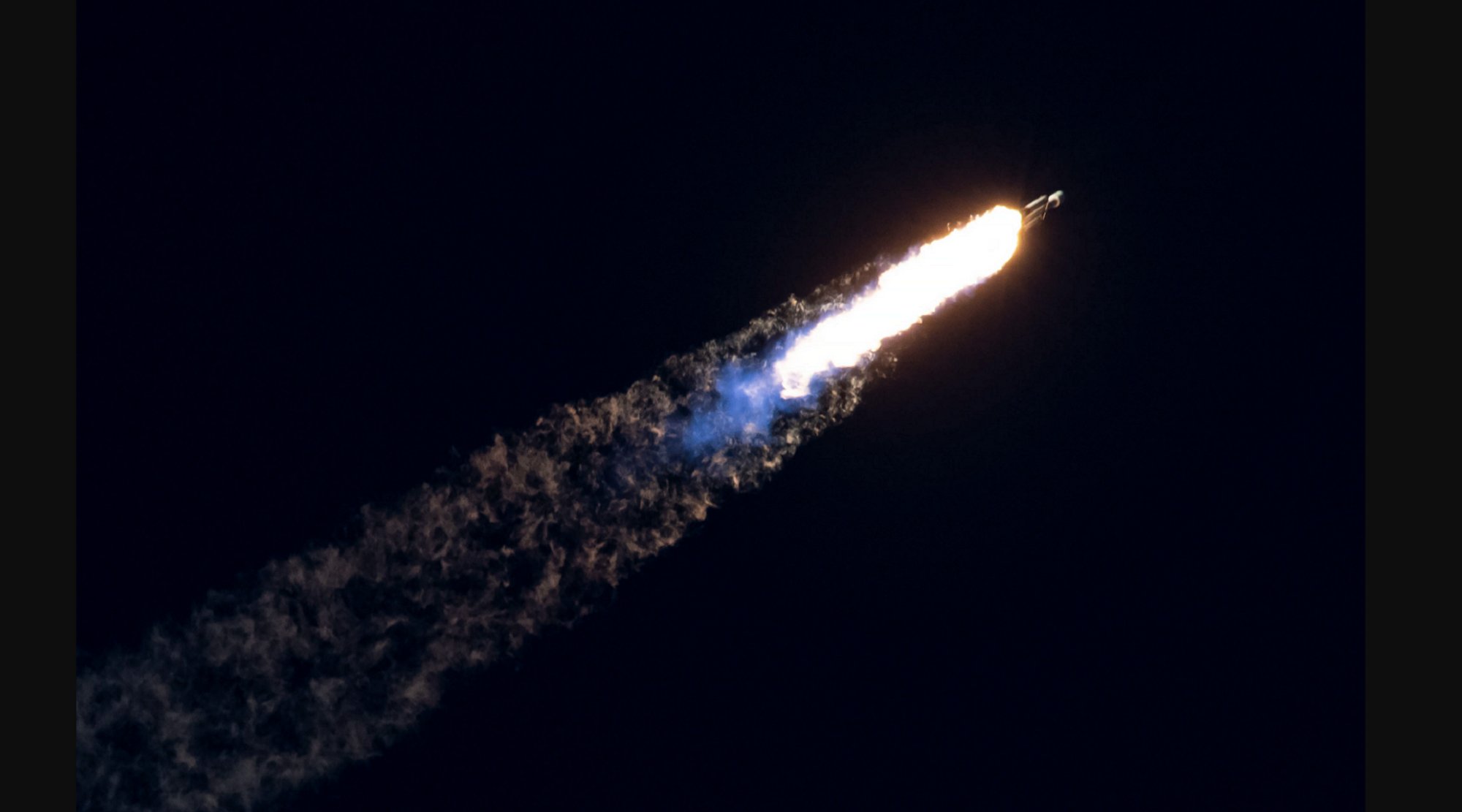

On Sunday, January 15, a SpaceX Falcon Heavy rocket lifted off to orbit with a payload for just the fifth time since the company began flying the 70-ton capacity vehicle in 2018.

Launching from NASA’s Kennedy Space Center at 5:56 p.m. EST, the partially reusable rocket carried USSF-67, a classified US Space Force mission consisting of two main payloads. The first held a military communications satellite destined for geosynchronous orbit, the Continuous Broadcast Augmenting SATCOM, or CBAS-2, according to a Space Force media release.
The second payload, the Long Duration Propulsive ESPA, or LDPE-3A, is a craft the Space Force uses for deploying multiple smaller payloads into low Earth orbit. In this case, the LDPE-3A carried five payloads, including a prototype of a secure space-to-ground communications device and another prototype designed for “enhanced situational awareness,” as per the Space Force announcement.
The most recent prior Falcon Heavy launch was also a Space Force mission, USSF-44, which launched from Kennedy Space Center on November 1. That was the first flight for the 229-foot-tall rocket since June 2019, a surprising slow pace given the sleeker Falcon 9 rocket launched a record-setting 48 times in 2022 alone.
What’s next for Falcon Heavy?
That the January 15 launch was only the fifth for the Falcon had nothing to do with Falcon Heavy itself, says Laura Forczyk, founder of the space industry analysis firm Astralytical. Instead, it was a result of delays in payloads for both NASA and the US military, including the USSF-44 mission launched in November, that kept the pace of launches low.
“It’s actually very common for payloads to be delayed,” Forcyzk notes. Meanwhile, the majority of SpaceX’s clientele don’t need a rocket as powerful as the Falcon Heavy, and so can fly on the more affordable Falcon 9, which the company uses to launch its own Starlink satellites. A Falcon 9 launch costs $67 million, according to SpaceX pricing, while a Falcon Heavy launch rings up to $97 million.
The Falcon Heavy is the most powerful launch vehicle SpaceX currently operates and consists of three of the company’s Falcon 9 rocket boosters strapped together side-by-side. The combined 27 Merlin engines provide 5 million pounds of thrust at liftoff, and when combined with an upper stage atop the middle booster, can lift up to 141,000 pounds into low Earth orbit.
That makes the Falcon Heavy “SpaceX’s current solution for launching medium- and large-sized payloads to orbit or beyond,” Forczyk says, but it’s not necessarily a long-term option. SpaceX’s massive Starship spacecraft and Super Heavy booster are still under development; as they become operational, there will be less and less need for Falcon Heavy launches. The company claims the more powerful Starship will generate 17 million pounds of thrust at liftoff and be capable of hauling more than 220,000 pounds into low Earth orbit.
[Related: SpaceX’s new Starshield program will supply satellite networks to the military]
But Starship has yet to fly in orbit, and in the meantime, Falcon Heavy launches are ramping up, with at least five scheduled so far in 2023. Those launches consist of another Space Force mission and two commercial satellite launches in the spring. NASA’s Psyche mission to an asteroid of the same name is also scheduled to launch sometime in October. That means we’ll probably be seeing a lot more of the Falcon Heavy before it fades away.
“The very fact that Falcon Heavy still exists and is still getting customers means there is a demand for it,” Forcyzk says. “They’re going to be launching more customer payloads, which is going to bring in more revenue for the company. They will absolutely need that as they are ramping up development of Starship.”

What’s next for SpaceX?
SpaceX is working steadily on developing the Starship vehicle, which when paired with the reusable Super Heavy Booster, will make it the largest rocket ever flown. Work had been delayed by years due to a prolonged Programmatic Environmental Review between SpaceX and the FAA necessary for the regulator to issue SpaceX a license for orbital Starship launches from Boca Chica, Texas. The process was finally completed in June 2022 with the FAA requiring some safety changes for the company’s site and protocols.
The next major milestone for Starship would be an uncrewed orbital test flight, but it’s unclear when that may take place, according to Forczyk. “A year ago, in January 2022, I gave a prediction that SpaceX would have its first orbital launch of Starship in 2022. And I was wrong,” she says. “So I want to say that they’re gonna have their first successful orbital Starship mission in 2023, but I don’t want to be wrong again.”
[Related: Dark matter, Jupiter’s moons, and more: What to expect from space exploration in 2023]
The company will need to get a move on, however. Not only is SpaceX contracted to fly a group of private citizens around the moon in the 2024, but NASA has contracted the company to create a lunar lander variant of Starship for use by NASA astronauts during the Artemis III mission scheduled for 2025.
In the meantime, SpaceX will continue launching everything from satellites to Crew Dragon spacecraft bound for the International Space Station atop its Falcon 9 rockets. In August, its CEO Elon Musk announced on Twitter that the company was aiming for 100 Falcon 9 flights in 2023. Less than a month in, it’s already successfully completed four Falcon 9 flights.
